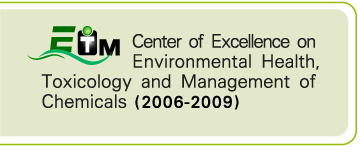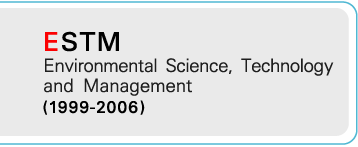|
This research project consists of field surveys and field experiment plus a detailed series of greenhouse experiments. Because of this the abstract was prepared in two parts. Part 1. Ecokinetics and potential risks of herbicides (paraquat and glyphosate) from farmland to the Chantaburi River and its estuary. Ecokinetics of paraquat (PQ) and glyphosate mixture running off from farmland to the Chanthaburi River and its estuary, Thailand were investigated through a transport and deposition pattern (hot spot positioning). At the same time vetiver grass strips as a mitigation measure were also established at a site located on the river bank. This demonstration site was aimed to reduce agrochemical mobilization and contamination into the river. Water, suspended solid (SS) and sediment samples along the chosen aquatic track were taken in both dry and wet seasons. PQ residues in all of the samples were determined by spectrophotometric method while glyphosate concentrations of the same samples were analyzed by high performance liquid chromatography (HPLC). Based upon field survey and sampling conducted along the aquatic track, the results showed that maximum concentrations of PQ and glyphosate residues in the water samples were occurred during the wet season from those five monitoring stations, among them three stations (S1,S2 and S3) representing the intensive agrochemical used areas. As PQ is strongly bound with particulate matters and transported with water flow, the highest PQ contamination was found in the estuary sediment (S5 = 0.66 mg/kg dry weight) in dry season and higher than glyphosate (S5 = 0.21 mg/kg wet weight). However, in those experimental plots with vetiver grass strips, the results indicate that the highest PQ residues from the collected water (1.86 µg/L), SS (2.38 mg/kg dry weight) and sediment (2.17 mg/kg dry weight) samples were obtained in the wet season. This could be explained due mainly to run-off from the ground lies above the grass plots receiving regular herbicide applications, carried out with the flows were mixture of agrochemicals including PQ and glyphosate. As expected both PQ and glyphosate accumulation in the sediment collected tanks of the planted plots (PQ = 0.76-1.44 mg/kg dry weight and glyphosate = 0.05-0.07 mg/kg wet weight) were found less than in the non-planted plots (PQ = 1.58-2.17 mg/kg dry weight and glyphosate = 0.08-0.09 mg/kg wet weight). This indicated that ground cover by this grass could minimize surface run-offs as well as soil erosion. Because of this agrochemicals when moved across those grass strips were trapped and broken down within the soil. Meanwhile, planting grass strips as a mitigation measure to reduce contamination and transportation of agrochemicals received farmers and surrounding communities’ attention. They were impressed by the results and confident to apply this simple and low cost technology at their fruit orchards and tree plantations to help safeguard water resource from agrochemical poisoning. Part 2. Removal of glyphosate and paraquat from agricultural soil using vetiver grass (Vetivaria sp.) Glyphosate and paraquat are herbicides which are widely used in agricultural activities. The herbicide mobilization and distribution as well as contamination are critical in Thailand because of the favorable local climate and the majority of Thai populations are farmers. Thus, vetiver grass which used as green barrier to prevent soil erosion and surface wash-off has taken part into prevents this transportation to happen. A series of greenhouses experiment was set up to determine the effects of the two chemicals which were glyphosate, paraquat, and also nanoscale zero-valent iron (nZVI) on growth and development of Vetiveria nemoralis. The concentration of glyphosate was 3432.10 mg/kg of soil while paraquat was at 1009.89 mg/kg of soil. The results showed that glyphosate had negative effects on V. nemoralis growth in height, length of root and formation of lignin in cell wall in the root. However glyphosate inhibited the uptake of plant nutrients such as iron, manganese, copper, and zinc. On the other hand, paraquat has shown its effect on induction of lignin formation. The highest percentage of glyphosate reduction was found in treatment of paraquat with glyphosate and V. nemoralis combination at 85.71% while the combination of paraquat with nZVI, V. nemoralis showed the highest paraquat reduction at 56.38% at week 12. Moreover, the accumulation of glyphosate was found in the shoot while paraquat was accumulated mainly in the root of V. nemoralis. In field study, vetiver grass was used for run-off prevention, the areas which were planted with Vetiveria zizanioides had glyphosate and paraquat residues in soil less than soil on the bare land at the same distance. The efficiency of vetiver strips on the reduction of glyphosate in the soil was found after the second strip while paraquat reduction was found after the third strip. This suggested that grass strips trapped those agrochemicals bounded with eroded materials. Thus, spread out of the contaminants to other environment could be minimized. แหล่งข้อมูล:
|
 Center of Excellence on Environmental Health and Toxicology (EHT)
Center of Excellence on Environmental Health and Toxicology (EHT)










